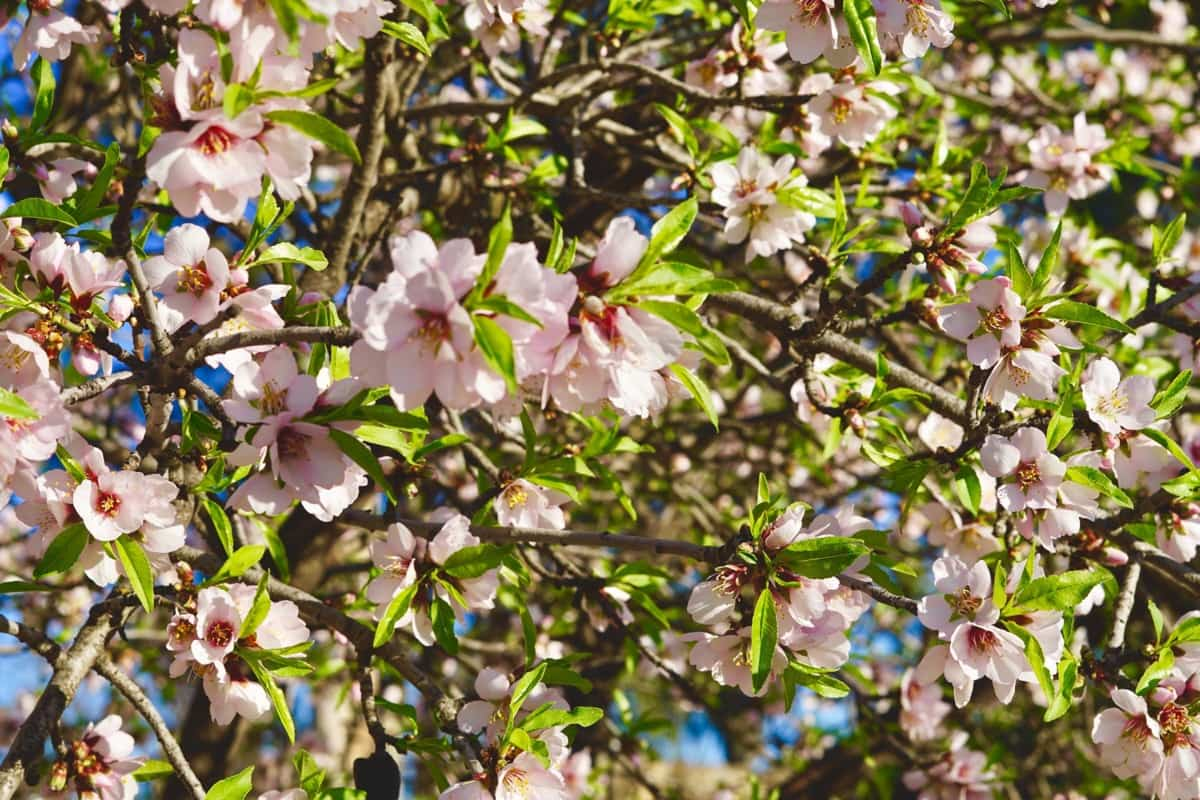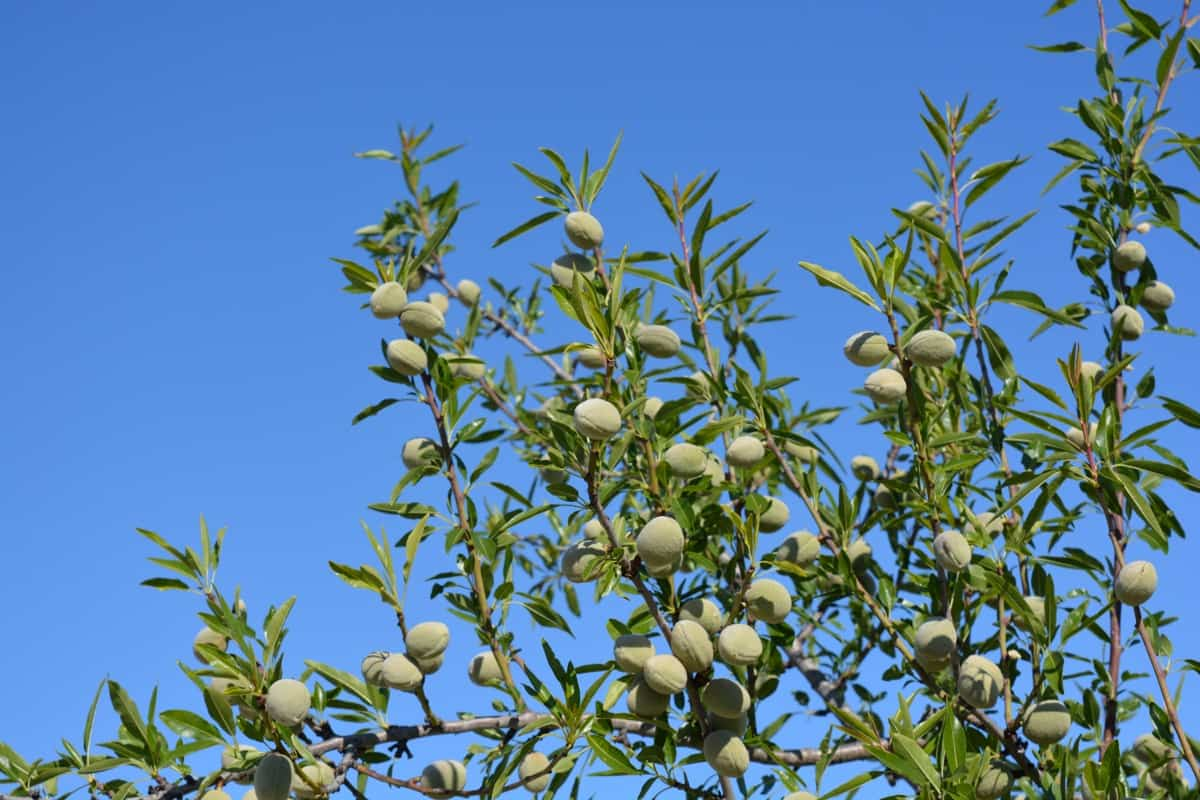Dying almond trees are a serious problem for orchard owners and can have a major impact on crop yields if left unchecked. Almond trees are vulnerable to several environmental factors, such as changes in weather, pests, and disease. There are several major causes of death among almond trees, and understanding how to address them is essential for maintaining them healthy and vibrant. Fortunately, a few major causes of dying almond trees discussed below can be identified and corrected with relative ease.

9 Causes of Dying Almond Trees
Why is My Almond Tree Dying in Summer Heat, and How to Save It?
Summer heat can cause an almond tree to die, and it’s important to understand the causes and take steps to save the tree. Almond trees are particularly prone to damage from the intense summer heat, especially if not properly watered and cared for.
Without the proper care, a tree may become weak and unable to withstand extreme temperatures. Regular and deep watering, mulching, pruning, and planting in a shaded area can help reduce the risk of the tree dying. Additionally, ensuring the soil is of good quality and well-draining can also help to reduce the risk of heat stress.
Preventing Almond Tree Death From Fungal Infections: Effective Remedies and Prevention Tips
Fungal infections can be a major problem for almond trees, leading to decreased yields and potential tree death. The most common type of fungal infection for the almond tree is a type of root rot known as Phytophthora. Phytophthora can cause root rot, cankers, and blight on the tree. Symptoms can include yellowing leaves, wilting, and stunted growth. This fungus thrives in wet, humid conditions, so keeping the soil around the tree well-drained is important to prevent it from spreading.
Practice good sanitation techniques around your almond tree. Prune away dead or damaged branches, and rake away fallen leaves or branches. Dispose of them properly, as leaving them near the tree can lead to fungal spread. Look for any signs of fungal infections, and remove any infected branches or leaves immediately. Fungicides can also be used to help protect your almond tree from fungal infections. The instructions on the product should be followed carefully, as over dosage can damage the tree.
Identifying Nutrient Deficiencies in Almond Trees and Remedies to Revive Them
Almond trees can suffer from various nutrient deficiencies that can cause stunted growth, yellowing of the leaves, and other health issues. Almond trees’ most common deficiencies include nitrogen, potassium, and magnesium. These deficiencies can be eliminated by using the right fertilizers and ensuring that the almond tree is receiving the right nutrients. Regular soil testing can help to ensure that the tree is receiving the proper nutrients, as well as help to identify any potential deficiencies. Proper watering and mulching can help the tree stay healthy and prevent nutrient deficiencies.
How to Protect Almond Trees From Pests and Diseases to Prevent Decline and Death
Almond trees are susceptible to various pests and diseases, including bacterial blight, black knot, peach twig borer, and brown rot. Bacterial blight, caused by the bacterium Xanthomonas arboricola, is a common disease of almond trees. Symptoms of bacterial blight include leaf spots, dark lesions on twigs and branches, and canker formation.
Control of bacterial blight can be achieved through the application of copper-based fungicides. To control pests and diseases that attack almond trees, it is important to practice good cultural practices. This includes proper pruning, fertilizing, irrigation, and tree monitoring for pest and disease activity signs. Utilizing the proper insecticides and fungicides is also important to ensure effective control.
Overwatering Issues in Almond Trees: Signs, Symptoms, and Steps to Rescue a Dying Tree
Overwatering is the common cause of death for almond trees. When almond trees are exposed to too much water, the roots may become waterlogged and deprived of oxygen. This can lead to root rot, stunting, or killing the tree. Additionally, overwatering can cause nutrient deficiencies since the excess water can leach out necessary nutrients. It can also lead to fungal diseases like root and crown rot.
In case you missed it: How to Start Almond Farming in the USA: A Step-By-Step Production Guide

To save an almond tree from dying due to overwatering, make sure the soil is well drained and avoid saturating the roots. This can be done by watering deeply but infrequently and ensuring adequate drainage from the soil. Check the soil regularly and adjust the watering schedule. If the tree exhibits signs of overwatering, such as wilted leaves, yellowing leaves, or root rot, reduce the amount of water it receives.
Underwatering Issues in Almond Trees: Signs, Symptoms, and Steps to Rescue a Dying Tree
Underwatering can kill your almond trees. The key to saving them is to ensure they are adequately watered. When watering almond trees, especially young trees, the key is to provide deep, infrequent watering. This means that the water should be penetrated deeply into the soil and should occur only when the soil’s top few inches are dry. If the soil remains constantly damp, the tree’s roots will not access the oxygen they need to be healthy.
When watering a tree, use a garden hose and slowly water the tree’s base in a circular motion. Do not water the tree leaves, which can cause fungus and insect problems. Do this until the soil is moist, about 8-12 inches deep. Depending on the tree size, this may require up to 80 liters of water. Finally, if the tree is under-watered, mulch the soil with organic matter like wood chips or straw to help retain moisture and improve soil quality.
Almond Tree Winter Damage/dying: Protecting Trees from Frost and Cold Temperatures
While they are well-suited to mild winters, they are not as resilient to colder climates and frosts. In extremely cold temperatures, almond trees can become damaged and even killed. When temperatures drop below freezing, almond tree bark, leaves, and flowers can suffer frost damage. If the temperature falls below -4°C, the tree’s vascular system will freeze, resulting in death.
Frost can also cause the leaves and buds to die, leading to fewer flowers and fruit. You can help save your almond tree from frost damage with extra effort. Planting in a sheltered area, insulating it, irrigating it regularly, and pruning it are all effective ways to ensure that your almond tree survives the winter months and thrives in the spring.
Improper Pruning May Cause Almond Tree Death: Pruning Methods for Healthy Growth
Incorrect pruning can kill almond trees. Almond trees require careful pruning to maintain their size and shape. If pruned too deeply or at the wrong time of year, it can kill the tree. The correct method of pruning in almond trees is only to remove dead or diseased branches and should not be more than one-third of the total canopy in any given season.
Furthermore, it is best to prune almond trees when they are dormant, usually during winter. Pruning during the summer months can cause stress on the tree and lead to disease. Proper pruning should also include thinning out overcrowded branches for better airflow and sunlight. Almond trees can be kept healthy and vigorous with correct pruning and bear plentiful fruit.
Reviving a Stressed Almond Tree: Rehabilitation Methods for Overall Recovery
Reviving a stressed almond tree can be challenging, but below steps can be taken to help the tree recover. The tree should be given proper care to ensure its long-term health and vitality.
- Check the soil for drainage, pH, and nutrient levels and amend them if required. Additionally, ensure the tree receives adequate water, sunlight, and airflow.
- Next, remove any existing pest or disease problems by pruning away infected branches, applying insecticides or fungicides, and introducing beneficial insects.
- Finally, the tree should be fertilized with a balanced fertilizer containing all the macro and micronutrients necessary for healthy growth. Fertilizer should be applied according to the manufacturer’s instructions.
The rehabilitation methods for an almond tree in distress include assessing the environment, removing existing pest or disease problems, and fertilizing with a balanced fertilizer. Proper care and attention can restore the tree to full health and vitality.
In case you missed it: How to Start Almonds Farming in California: A Step-By-Step Production Guide for Planting to Harvest

Conclusion
Addressing the major causes of death among almond trees is important to keep almond trees healthy and vibrant. This can be done by providing almond trees with consistent temperatures, inspecting them for pests and disease, and providing them with quality soil and regular fertilization. These steps allow almond trees to be kept healthy and vibrant for years.
- Feed Your Flock for Less: Top 10 Tips to Save on Chicken Feed
- Ultimate Guide to Ossabaw Island Hog: Breeding, Raising, Diet, and Care
- Hatching Answers: The Top 10 Reasons Your Chickens Aren’t Laying Eggs
- Eggs and Economics: Breaking Down the Cost of Raising Backyard Chickens
- Defend Your Greens: Proven Methods to Keep Iguanas Out of Your Garden
- Ultimate Guide to Cinnamon Queen Chicken: A Comprehensive Guide for Beginners
- Ultimate Guide to California Tan Chicken: Breeding, Raising, Diet, Egg-Production and Care
- Ultimate Guide to Marsh Daisy Chicken: Breeding, Raising, Diet, and Care
- 10 Types of Chicken Farming Businesses You Can Start for Profits